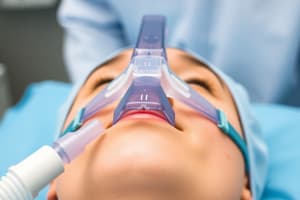Podcast
Questions and Answers
A nasopharyngeal airway is inserted:
A nasopharyngeal airway is inserted:
- Into the smaller nostril with the tip following the roof of the nose.
- With the bevel pointing downward if inserted into the left nare.
- With the bevel facing the septum if inserted into the right nare. (correct)
- Into the larger nostril with the tip pointing away from the septum.
How should you manage the airway of a 23-year-old male with severe head trauma?
How should you manage the airway of a 23-year-old male with severe head trauma?
Alternate 15 seconds of oral suctioning with 2 minutes of assisted ventilation.
Which of the following factors will cause a decreased minute volume in an adult?
Which of the following factors will cause a decreased minute volume in an adult?
- Increased tidal volume
- Slight decrease in respiratory rate
- Shallow breathing (correct)
- Respirations of 20 breaths/min
In which of the following situations should supplemental oxygen be administered?
In which of the following situations should supplemental oxygen be administered?
What should you do when the dentures of an apneic woman become loose during ventilation?
What should you do when the dentures of an apneic woman become loose during ventilation?
An oxygen cylinder should be taken out of service and refilled when the pressure inside it is less than:
An oxygen cylinder should be taken out of service and refilled when the pressure inside it is less than:
Intrapulmonary shunting occurs when blood from the right side of the heart:
Intrapulmonary shunting occurs when blood from the right side of the heart:
The partial pressure of oxygen in the alveoli is _______ mm Hg, while the partial pressure of carbon dioxide in the alveoli is _______ mm Hg.
The partial pressure of oxygen in the alveoli is _______ mm Hg, while the partial pressure of carbon dioxide in the alveoli is _______ mm Hg.
Gas exchange in the lungs is facilitated by:
Gas exchange in the lungs is facilitated by:
After ___________ minutes without oxygen, brain damage is very likely.
After ___________ minutes without oxygen, brain damage is very likely.
What should you do if a person is choking and shows signs like cyanosis?
What should you do if a person is choking and shows signs like cyanosis?
All of the following are signs of hypoxia, EXCEPT:
All of the following are signs of hypoxia, EXCEPT:
Flashcards are hidden until you start studying
Study Notes
Nasopharyngeal Airway Insertion
- Insert a nasopharyngeal airway into the larger nostril, with the tip pointing away from the septum.
- For the right nare, the bevel should face the septum; for the left nare, it should point downwards.
Airway Management in Trauma
- Manage airway for an unconscious patient with severe head trauma by providing continuous ventilations with a bag-valve mask.
- Suction oropharynx of bloody secretions using a rigid catheter until clear.
- Alternate 15 seconds of suctioning with 2 minutes of assisted ventilation to maintain oxygenation.
Factors Affecting Minute Volume
- Shallow breathing leads to decreased minute volume in adults.
- A slight decrease in respiratory rate can also contribute to lowered minute volume.
Supplemental Oxygen Guidelines
- Administer supplemental oxygen if exposure to carbon monoxide occurs, even with an oxygen saturation of 95%.
- Oxygen should be provided for any diabetic patient with saturation less than 98%.
- In cases of myocardial infarction with saturation at 97%, supplemental oxygen is not indicated.
- For elderly patients, supplemental oxygen is required if saturation drops below 95%.
Bag-Valve Mask Ventilation
- In a woman with loose dentures being ventilated, remove dentures and resume ventilations while assessing for adequate chest rise.
Oxygen Cylinder Pressure Standards
- An oxygen cylinder should be refilled when pressure is less than 500 psi.
Intrapulmonary Shunting
- Intrapulmonary shunting occurs when unoxygenated blood bypasses nonfunctional alveoli, returning to the heart without proper oxygenation.
- Impaired gas exchange can stem from several physiological issues, such as decreased alveolar surface tension due to surfactant problems.
Partial Pressure of Gases in Alveoli
- The partial pressure of oxygen in the alveoli is 104 mm Hg.
- The partial pressure of carbon dioxide in the alveoli is 40 mm Hg.
Importance of Surfactant
- Adequate surfactant in the lungs is essential for effective gas exchange, preventing issues caused by water or blood in the alveoli.
Oxygen Deprivation and Brain Damage
- Brain damage is likely after 6 to 10 minutes without oxygen supply.
Response to Choking
- For a person experiencing choking with weak cough and cyanosis, administer abdominal thrusts from behind rather than delivering back blows or placing the person supine.
Signs of Hypoxia
- Signs of hypoxia include weak pulse, tachycardia, and cyanosis; dehydration is not a direct sign of hypoxia.
Studying That Suits You
Use AI to generate personalized quizzes and flashcards to suit your learning preferences.




